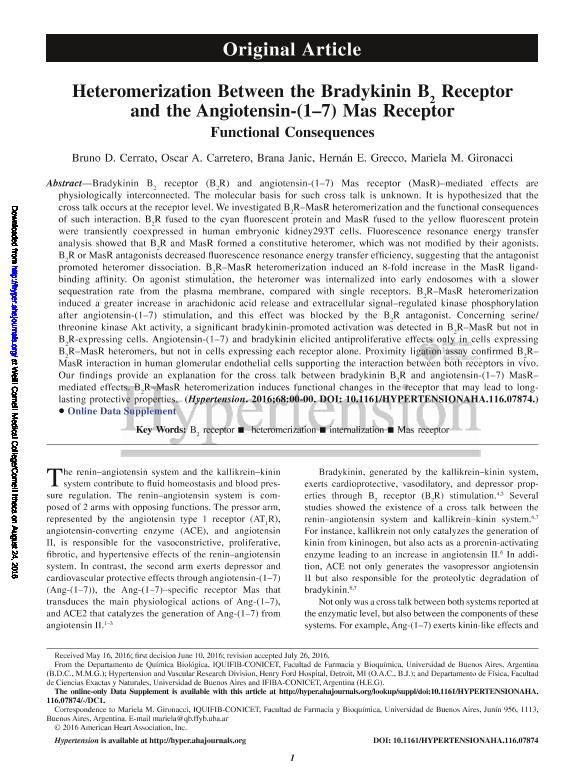Artículo
Heteromerization Between the Bradykinin B 2 Receptor and the Angiotensin-(1-7) Mas Receptor Novelty and Significance
Cerrato, Bruno Diego ; Carretero, Oscar A.; Janic, Brana; Grecco, Hernan Edgardo
; Carretero, Oscar A.; Janic, Brana; Grecco, Hernan Edgardo ; Gironacci, Mariela Mercedes
; Gironacci, Mariela Mercedes
 ; Carretero, Oscar A.; Janic, Brana; Grecco, Hernan Edgardo
; Carretero, Oscar A.; Janic, Brana; Grecco, Hernan Edgardo ; Gironacci, Mariela Mercedes
; Gironacci, Mariela Mercedes
Fecha de publicación:
10/2016
Editorial:
Lippincott Williams
Revista:
Hypertension
ISSN:
0194-911X
Idioma:
Inglés
Tipo de recurso:
Artículo publicado
Clasificación temática:
Resumen
Bradykinin B2 receptor (B2R) and angiotensin-(1–7) Mas receptor (MasR)–mediated effects are physiologically interconnected. The molecular basis for such cross talk is unknown. It is hypothesized that the cross talk occurs at the receptor level. We investigated B2R–MasR heteromerization and the functional consequences of such interaction. B2R fused to the cyan fluorescent protein and MasR fused to the yellow fluorescent protein were transiently coexpressed in human embryonic kidney293T cells. Fluorescence resonance energy transfer analysis showed that B2R and MasR formed a constitutive heteromer, which was not modified by their agonists. B2R or MasR antagonists decreased fluorescence resonance energy transfer efficiency, suggesting that the antagonist promoted heteromer dissociation. B2R–MasR heteromerization induced an 8-fold increase in the MasR ligand-binding affinity. On agonist stimulation, the heteromer was internalized into early endosomes with a slower sequestration rate from the plasma membrane, compared with single receptors. B2R–MasR heteromerization induced a greater increase in arachidonic acid release and extracellular signal–regulated kinase phosphorylation after angiotensin-(1–7) stimulation, and this effect was blocked by the B2R antagonist. Concerning serine/threonine kinase Akt activity, a significant bradykinin-promoted activation was detected in B2R–MasR but not in B2R-expressing cells. Angiotensin-(1–7) and bradykinin elicited antiproliferative effects only in cells expressing B2R–MasR heteromers, but not in cells expressing each receptor alone. Proximity ligation assay confirmed B2R–MasR interaction in human glomerular endothelial cells supporting the interaction between both receptors in vivo. Our findings provide an explanation for the cross talk between bradykinin B2R and angiotensin-(1–7) MasR–mediated effects. B2R–MasR heteromerization induces functional changes in the receptor that may lead to long-lasting protective properties.
Palabras clave:
B2 Receptor
,
Heteromerization
,
Internalization
,
Mas Receptor
Archivos asociados
Licencia
Identificadores
Colecciones
Articulos(IFIBA)
Articulos de INST.DE FISICA DE BUENOS AIRES
Articulos de INST.DE FISICA DE BUENOS AIRES
Articulos(IQUIFIB)
Articulos de INST.DE QUIMICA Y FISICO-QUIMICA BIOLOGICAS "PROF. ALEJANDRO C. PALADINI"
Articulos de INST.DE QUIMICA Y FISICO-QUIMICA BIOLOGICAS "PROF. ALEJANDRO C. PALADINI"
Citación
Cerrato, Bruno Diego; Carretero, Oscar A.; Janic, Brana; Grecco, Hernan Edgardo; Gironacci, Mariela Mercedes; Heteromerization Between the Bradykinin B 2 Receptor and the Angiotensin-(1-7) Mas Receptor Novelty and Significance; Lippincott Williams; Hypertension; 68; 4; 10-2016; 1039-1048
Compartir
Altmétricas



